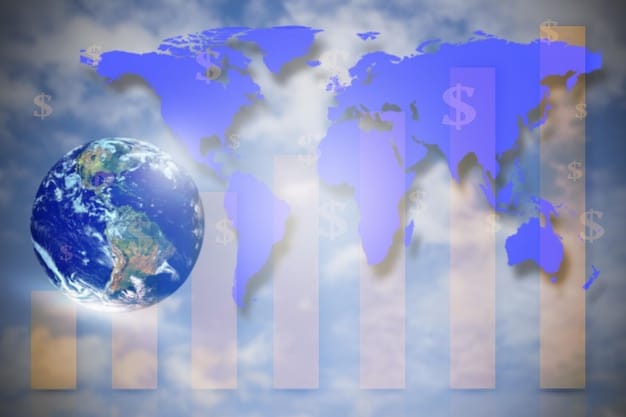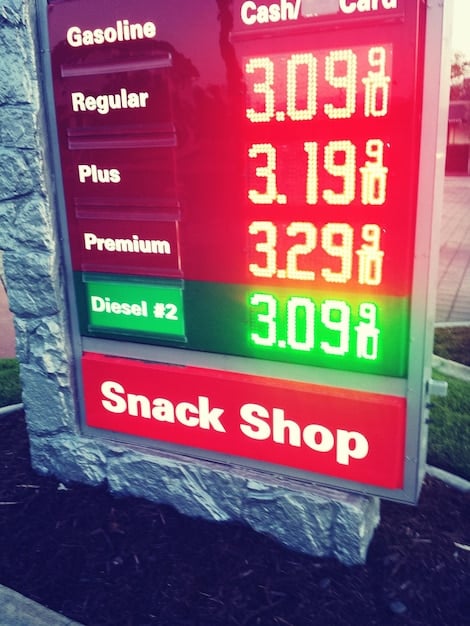Global Conflicts’ Impact: US Economy Under Pressure

The impact of global events, particularly international conflicts, significantly affects the U.S. economy through various channels including trade disruptions, increased defense spending, and fluctuations in commodity prices, creating both challenges and opportunities for American businesses and consumers.
The interconnectedness of the modern world means that the impact of global events, especially international conflicts, reverberates across borders, significantly influencing the U.S. economy. From rising inflation to supply chain disruptions, understanding these impacts is crucial for American businesses and consumers alike.
Understanding the Interconnected Global Economy
The global economy is a complex web of interconnected systems, where events in one region can have far-reaching consequences. International conflicts, in particular, can trigger a cascade of economic effects that impact countries around the world, including the United States. Understanding these connections is the first step in navigating the challenges they present.
From trade routes to financial markets, the U.S. economy is deeply integrated with the rest of the world. Disruptions in one area can quickly spread, affecting American businesses, consumers, and the overall economic outlook.

The Role of Trade and Supply Chains
International trade is a cornerstone of the global economy, with the U.S. relying on imports for everything from raw materials to finished goods. Conflicts can disrupt these trade routes, leading to shortages and increased prices. The impact on supply chains can be felt across various sectors of the U.S. economy.
Defense spending increases, and geopolitical instability can shift trade priorities as well.
- Increased shipping costs due to rerouting and insurance premiums.
- Shortages of key components impacting manufacturing.
- Higher prices for consumers as businesses pass on increased costs.
- Decreased exports due to disrupted foreign markets.
Therefore, global conflicts can have a variety of outcomes on the U.S. economy.
The Impact of Geopolitical Instability on Financial Markets
Financial markets are particularly sensitive to geopolitical instability. Uncertainty surrounding international conflicts can lead to volatility in stock prices, currency values, and interest rates. Investors often react to news of conflicts by shifting assets to safer havens, such as U.S. Treasury bonds, which can drive down interest rates and impact borrowing costs.
The impact on U.S. investment and trade can happen quickly and last for an extended amount of time.
Investor Confidence and Market Volatility
When conflicts escalate, investors tend to become risk-averse, leading to a sell-off of stocks and other risky assets. This can cause significant market volatility and erode investor confidence, potentially impacting retirement savings and investment portfolios. The stock market’s performance is often a reflection of investor sentiment, making it a key indicator of economic health.
This volatility can lead to a higher degree of risk.
Currency Fluctuations and Their Effects
International conflicts can also trigger fluctuations in currency values. As investors seek safe havens, the U.S. dollar often strengthens, making American exports more expensive and imports cheaper. This can hurt U.S. businesses that rely on exports, while benefiting consumers who can purchase imported goods at lower prices.
These fluctuations can have a massive impact on many different sectors.
Rising Energy Prices and Inflation
One of the most immediate and visible impacts of international conflicts is the surge in energy prices. Conflicts in oil-producing regions can disrupt production and supply, leading to higher prices at the pump and increased costs for businesses. This inflationary pressure can ripple through the economy, affecting everything from groceries to transportation.
Both businesses and individual consumers are affected by these forces.

The Role of Oil-Producing Regions
Conflicts in regions like the Middle East, which are major oil producers, can have a particularly significant impact on global energy markets. Disruptions to oil supplies can lead to a rapid increase in prices, which can then be passed on to consumers in the form of higher gasoline prices and utility bills.
These increases may cause considerable pressure.
The Broader Impact on Inflation
Rising energy prices contribute to overall inflation, which erodes the purchasing power of consumers and can lead to decreased spending. As businesses face higher energy costs, they may need to raise prices for their goods and services, further fueling inflation. This can create a vicious cycle that is difficult to break.
This vicious cycle can be difficult to stop.
Increased Defense Spending and its Economic Consequences
International conflicts often prompt governments to increase defense spending. While this can provide a boost to the defense industry, it also diverts resources from other sectors of the economy, such as education, infrastructure, and healthcare. The long-term economic consequences of increased defense spending can be complex. It can be a significant drag to the economy.
How does it affect the U.S. economy?
The Trade-offs of Military Spending
Increased military spending can lead to higher budget deficits and increased borrowing, which can put pressure on interest rates and potentially slow economic growth. Additionally, resources allocated to defense may not be available for investments in areas that could generate higher economic returns.
Therefore, a strong approach is needed.
The Impact on Innovation and Technology
While defense spending can drive innovation in certain areas, such as aerospace and cybersecurity, it may also crowd out investment in other sectors. Some economists argue that resources channeled into military research and development could be better used to support civilian industries and promote broader technological advancements.
Military advancement can lead to advancement in other sectors as well.
Humanitarian Crises and Economic Strain
International conflicts often result in humanitarian crises, with large-scale displacement of people and disruptions to essential services. Providing humanitarian aid and supporting refugees can place a significant strain on the economies of neighboring countries and international organizations. The U.S., as a major donor, can feel the economic impact of these crises.
It is vital to provide appropriate assistance and relief.
The Cost of Humanitarian Aid
The U.S. government provides billions of dollars in humanitarian aid each year to support refugees and address the consequences of conflicts around the world. While this aid is essential for alleviating suffering, it also represents a significant financial commitment that can impact the U.S. budget and economy.
There are various forms of relief.
The Ripple Effects on Global Stability
Humanitarian crises can also have broader economic consequences, such as disrupting trade, destabilizing regions, and creating security risks. These ripple effects can indirectly impact the U.S. economy through increased geopolitical instability and the need for additional security measures.
The U.S. continues to monitor for any problems.
Opportunities for U.S. Businesses
While international conflicts present numerous challenges, they can also create opportunities for certain U.S. businesses. For example, companies in the defense, cybersecurity, and reconstruction sectors may see increased demand for their products and services. Additionally, conflicts can prompt innovation and the development of new technologies.
It may vary though based on the location.
Defense and Cybersecurity Industries
As governments around the world increase defense spending in response to conflicts, U.S. companies that provide military equipment, cybersecurity solutions, and related services may see a surge in orders. This can lead to job creation and economic growth in these sectors.
It is important to note that some locations are safer than others.
Reconstruction and Development
Following conflicts, there is often a need for reconstruction and development efforts to rebuild infrastructure, provide essential services, and promote economic recovery. U.S. companies with expertise in engineering, construction, and development may find opportunities to participate in these projects.
These improvements have the potential to offer solutions.
Policy Responses and Mitigation Strategies
The U.S. government has a range of policy tools at its disposal to mitigate the economic impact of international conflicts. These include diplomatic efforts to de-escalate tensions, economic sanctions to pressure aggressors, and fiscal and monetary policies to stabilize the domestic economy. Developing effective policy responses is crucial for minimizing the negative consequences of conflicts.
It is important to consider all of the policies.
Economic Sanctions and Their Effectiveness
Economic sanctions are often used as a tool to pressure countries involved in conflicts to change their behavior. However, sanctions can also have unintended consequences, such as disrupting trade, harming civilian populations, and undermining diplomatic efforts. Assessing the effectiveness of sanctions is essential for ensuring that they achieve their intended goals.
These are typically done as a last resort.
Fiscal and Monetary Policy Measures
The Federal Reserve can use monetary policy tools, such as adjusting interest rates and buying or selling government bonds, to stabilize the U.S. economy in the face of international conflicts. The government can also implement fiscal policy measures, such as increasing spending or cutting taxes, to stimulate economic growth. These measures can help to buffer the U.S. economy from the negative effects of conflicts.
The government has a variety of useful tools.
| Key Point | Brief Description |
|---|---|
| 📉 Market Volatility | Conflicts cause uncertainty, leading to stock market fluctuations and investor hesitation. |
| ⛽ Energy Prices | Conflicts disrupt oil production, increasing fuel costs and contributing to overall inflation. |
| 🛡️ Defense Spending | Increased military expenditure can divert resources from sectors like education and infrastructure. |
| 🌍 Trade Disruptions | Conflicts interfere with global trade routes, leading to shortages and higher import/export costs. |
Frequently Asked Questions
▼
International conflicts generally increase market volatility. Investors often move assets to safer options, causing stock prices to fluctuate and potentially decline because of uncertainty.
▼
Energy prices can rise because conflicts disrupt oil production and distribution, potentially leading to decreased supply and higher demand for available resources.
▼
Increased defense spending may stimulate certain sectors but may also divert resources from vital areas such as education, healthcare, and infrastructure.
▼
Global conflicts disrupt established trade routes, leading to increased shipping costs, shortages of goods, and overall inflation in importing and exporting nations.
▼
Policy measures include applying economic sanctions, diplomatic interventions, and implementing strategic fiscal and monetary strategies to stabilize the domestic economy and reduce negative impact.
Conclusion
In conclusion, the impact of global events, notably international conflicts, present complex and multifaceted challenges to the U.S. economy. From market volatility and increased energy prices to humanitarian crises and shifting trade dynamics, understanding these interconnected influences is vital for policymakers, businesses, and citizens to make informed decisions and navigate the complexities of the modern world.